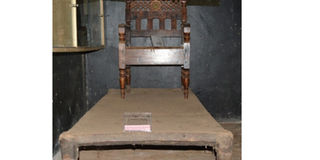Inside Kooki chiefdom’s museum

Kamuswaga Kezekia Ndawula’s royal bed and chair which he used between 1820 to 1854. PHOTO BY IVAN KIMBOWA
In the heart of Rakai Town lies a site the size of a football pitch. For passersby, it can pass for a residential house given its serene and organised environment, but actually, this is a museum housing Kooki chiefdom’s ancient cultural heritage.
It is the first museum to be established in Kooki chiefdom led by Kamuswaga Apollo Ssansa Kabumbuli II. It was officially opened on May 15, 2015, as he celebrated his 11th coronation anniversary.
Back to the roots
“The museum intends to give the populace an idea about the authentic tradition of the bakooki which our ancestors used to believe in,” David Kato, one of the guides at the museum, says.
Inside the museum, there are varied and well-captioned Kooki Chiefdom’s ethnographic collection covering clothing, hunting and agriculture. There are also music and dance instruments, crafts and materials which were used in spiritual healing in Kooki.
A traditional royal crown, which is said to have been used in the coronation of the first Kamuswaga in 1740s, is in display. “The reigning Kamuswaga decided to design a new crown and let the old one be taken to the museum,” says Kato.
Kato reveals one of the traditions surrounding this crown. “Women who are menstruating are not supposed to touch the (royal crown) since it is believed that this may cause tragedy.”
Kamuswaga Kezekia Ndahura’s royal bed, which was made using only wood and animal skin, is also on display and so is the royal gown of George Sefasi Joje Kabumbuli I. Three different types of baskets are on display at one side of the hall. “One was used in harvesting of seeds, the other in clearing and then third for storing them,” Kato explains.
There are also different bark cloths in red, black and white which Kato says were made out of the inner bark of the mutuba tree (ficus natalensis) which is seemingly extinct due to deforestation. “They were not mixed in any foreign colour. They are in their original form, however, such trees cannot be found in our forests today,” he says.
Some shelves exhibit more recent items such as coins used as currency from 1909-1989, traditional music instruments such as shakers (ensasi), flute and adungu.
“Those were some of the chiefdom’s regalia that had been taken to the Uganda Museum for custody after Obote I government abolished cultural institutions in Uganda in 1966, but we have since got them back,” Kato says.
Various shoes that belonged to Sefasi Jejo (1907-54) are also on display. According to Kato Jejo had been advised to use them by his healers due to a foot problem at the time.
Big and small animal trappers, decorated seats of different generations, letter written by King Muteesa I to Queen Elizabeth, and aged clay pots that were used during different functions; are all on display. In addition, there are photos of current kings and cultural leaders in Uganda, including the Kamuswaga.
Uniqueness in dialect
The bakooki believe in different pronunciations of words, proverbs and idioms. Some of the proverbs in Lukooki include enjuba eragire teyata bwato literally meaning ‘an identified buffalo can never break a boat’, alya atunga adduula loosely translated as when one gets better, they become braggart.
According to Kato, touring of the site is still free of charge until completion of the Kamuswaga Royal Park.
“It is upon one to make a request and be given time to tour but currently we gain from the crafts shop which people visit and buy different items,” Kato said.
The Kamuswaga’s lake that seems to be drying up lies outside the museum. According to Kato, the lake had dried up completely but when the Kamuswaga was enthroned, it ‘mysteriously’ regained its water. “It had been dry for years, but when the chiefdom drums were sounded in 2004, the lake recovered its waters.”
“This development pleased everyone in Kooki since the whole community now fetches water for home consumption from this source,” says Robert Kanyike, who stays near the Kamuswaga Royal Park.
Bright future ahead
Godfrey Kimbugwe, the deputy prime minister of Kooki Chiefdom, says by establishing the museum, they are preserving their traditional heritage as well as contributing to the tourism sector in greater Masaka and Uganda.
“We have started to build cottages that will cover almost two acres of land mainly to accommodate tourists who will visit to witness the natural beauty of Kooki,” Kimbugwe says.
The established Kamuswaga’s Royal Park currently consists a conference hall, rest gardens, a bar, cultural museum and other buildings and cottages which are still under construction.




